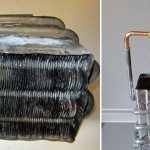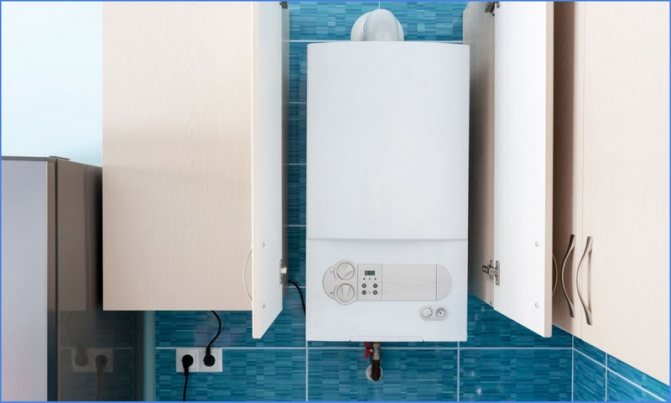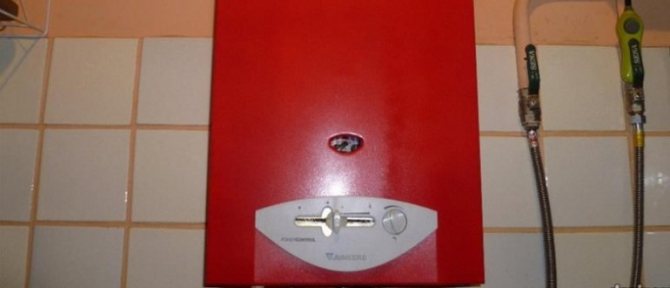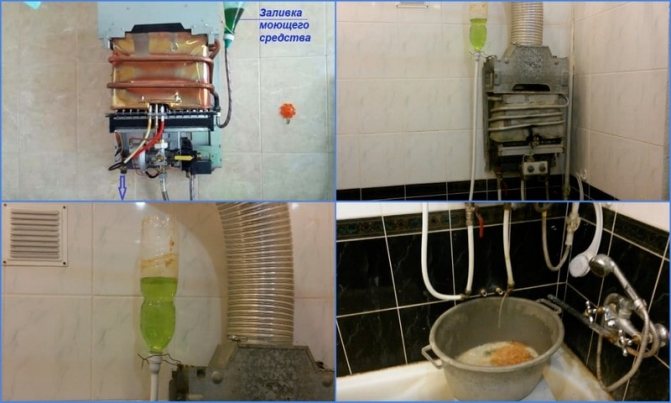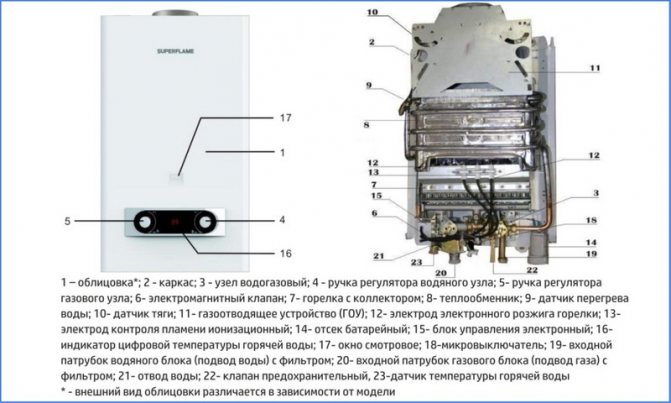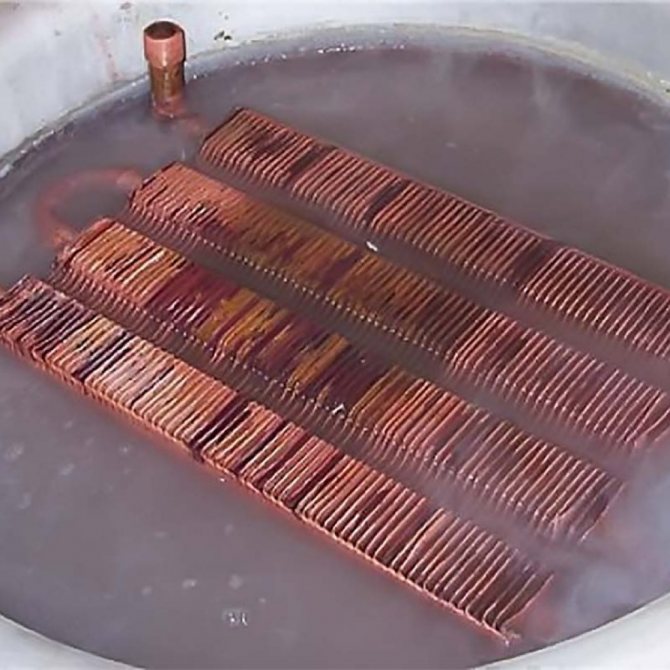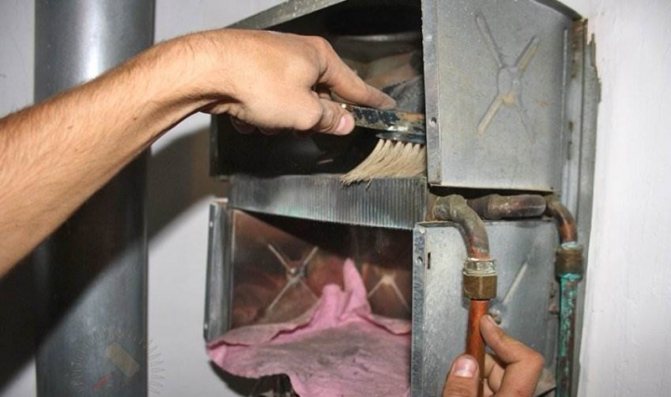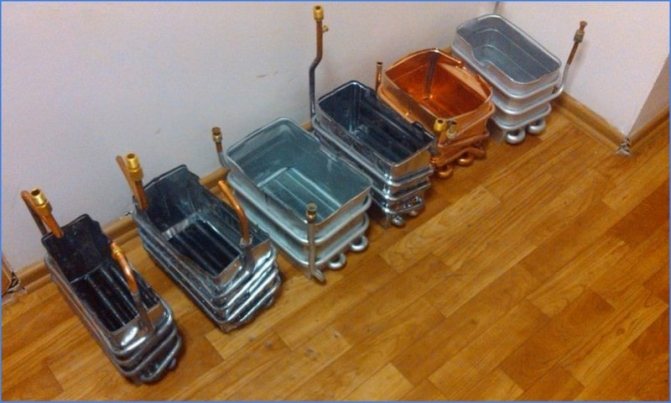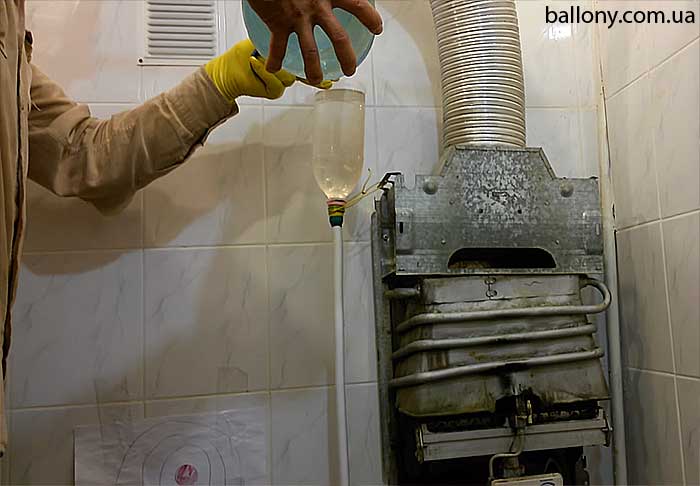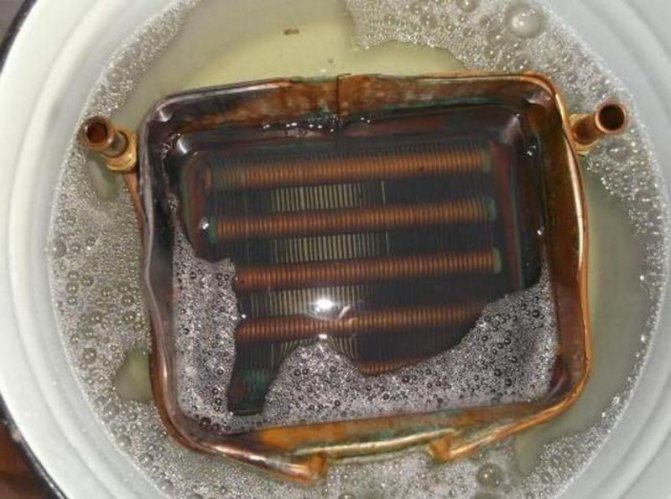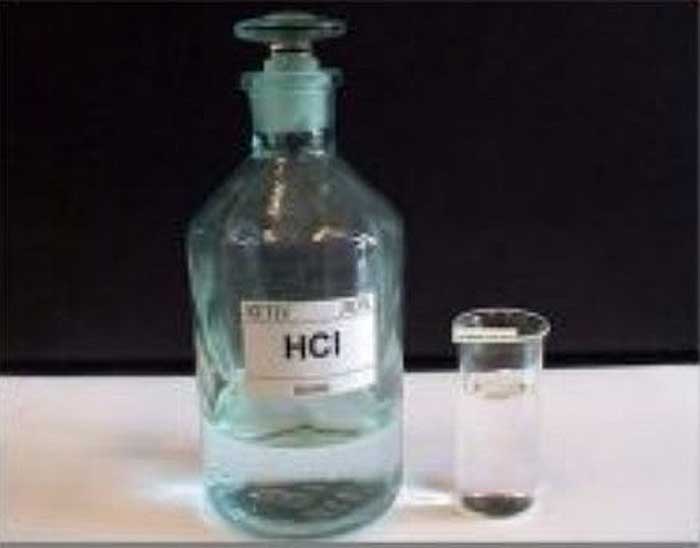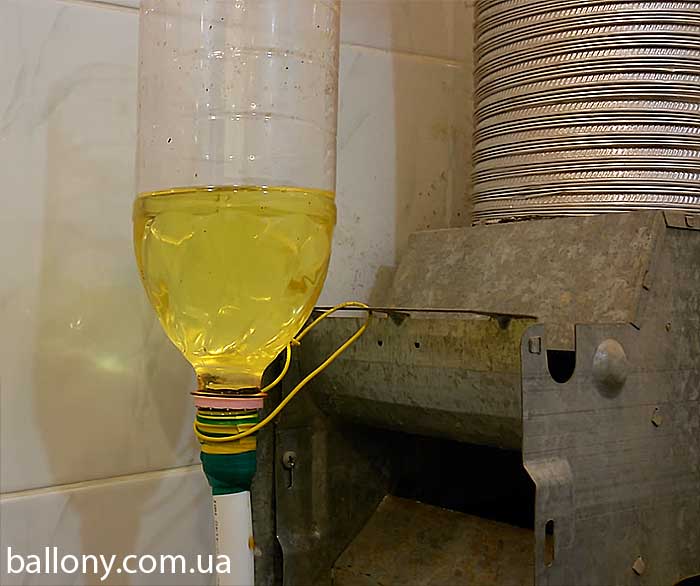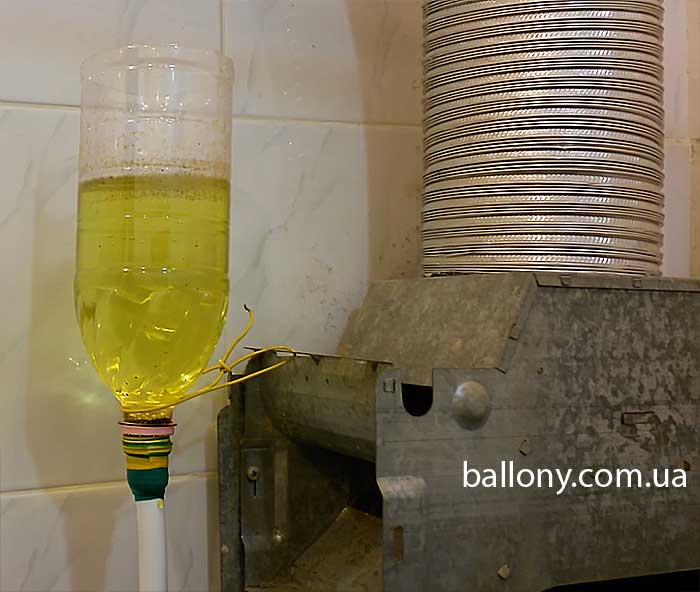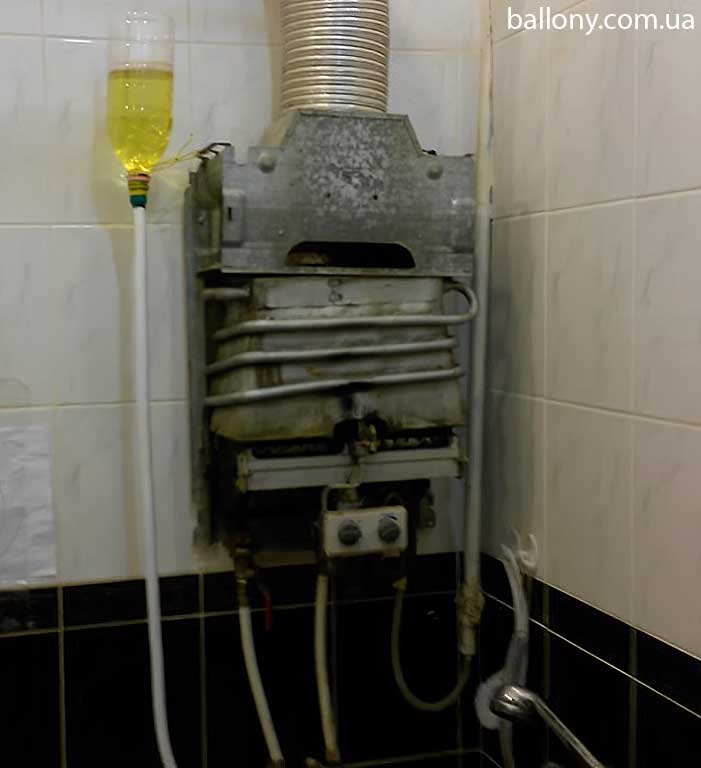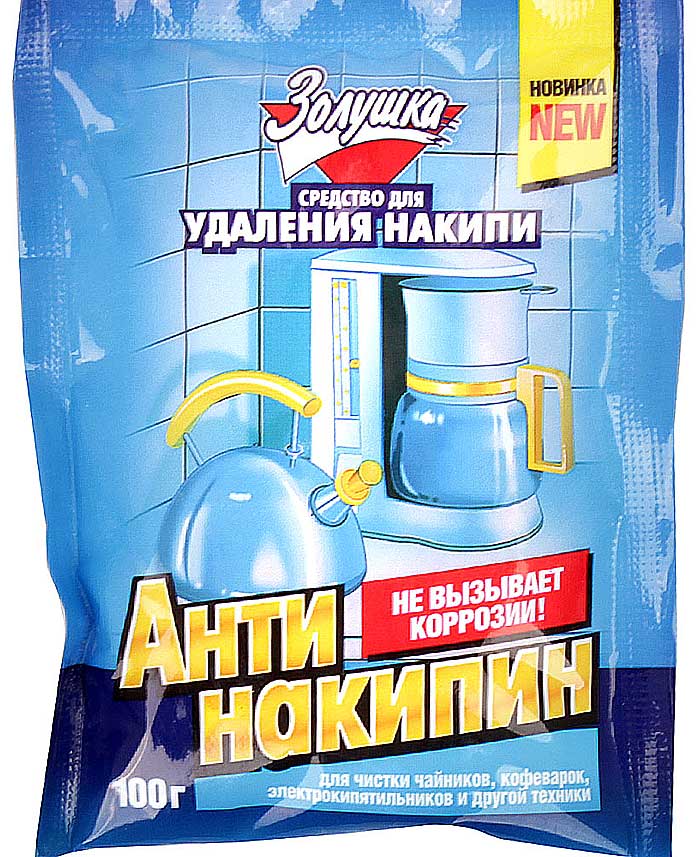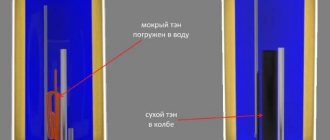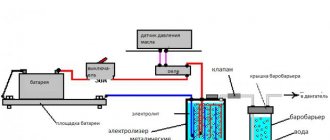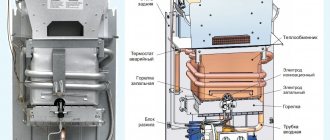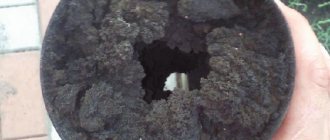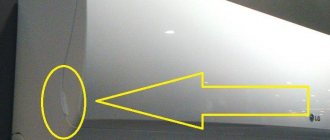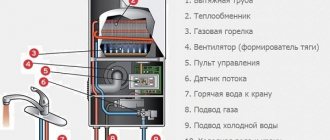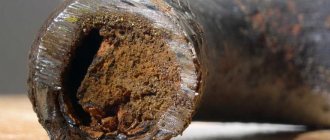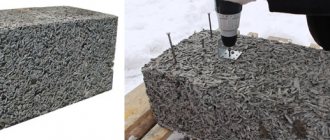To ensure regular hot water supply for their house or apartment, many owners install a gas boiler in the kitchen. The device is compact, does not take up much space on the wall, and even a teenager can figure out how it works.
Such water heating equipment will serve its owner "faithfully" for more than a dozen years, but only under the condition of correct operation and periodic cleaning. How to rinse and clean the gas water heater with your own hands at home (for example, the Zanussi GWH 10 Fonte Glass Rialto model)? For more information, see the article.
Why are the "insides" of the gas column clogged?
The reason for such contamination lies in the principle of operation of the device. The device heats water with gas, and therefore accumulations of soot and carbon deposits cannot be avoided. In addition, the incendiary element itself is very often contaminated, collecting soot on its wick.
But the real apocalypse comes when scale "settles" in the pipes of the water heater. It not only interferes with the normal operation of the equipment, but can completely disable it, completely clogging the plumbing part. The formation of scale in the heat exchanger is especially dangerous.
The heat exchanger is a collection of tubes placed above the gas burner. Water should flow through them constantly and unhindered, it is in them that it evenly heats up. When scale builds up in these pipes, hot water supply interruptions occur.
You may be interested in: 9 important questions when choosing a gas water heater
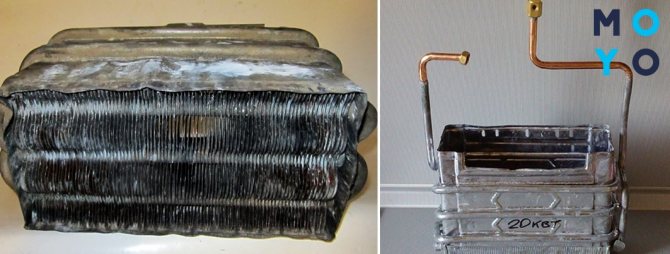
Scale reasons
Soot and scale appear in the mechanism of the gas water heater during the period of use. The reason for this is not only the exhaust gas vapors, by means of which the liquid is heated. But also the use of hard water, which settles on the walls of the pipes, leading to a decrease in the operation of the device.
Signs that indicate a clogged gas column:
- A thin jet of hot water.
- After turning on the water, the column turns off.
- The device does not turn on.
- The heating of the liquid is reduced.
- The column works sporadically, although the water pressure does not change.
- The device cools for a long time, protection is constantly triggered.
You can externally assess the condition of the device - look at the awning and visually assess the degree of pollution.
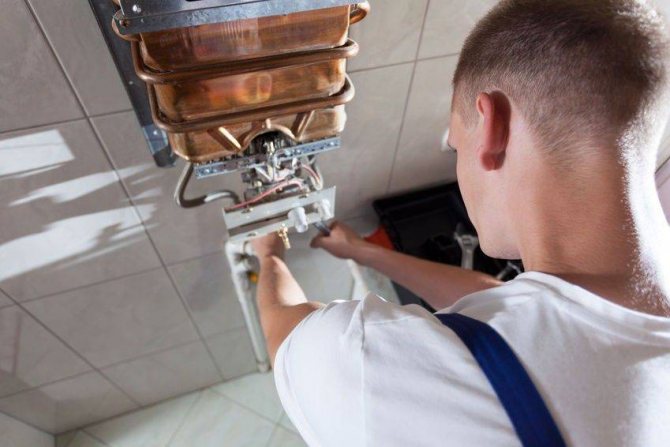

It's time to cleanse: the first signs
You can determine that a gas water heater (for example, from Bosch) needs cleaning by 4 characteristic signs:
- The device stopped turning on or often goes out during operation... When there is 100% certainty that gas is supplied to the column without interruption, and water is supplied with a stable pressure, the reason for such independent shutdowns may be an excessive amount of burning on the incendiary element. The problem can be eliminated only by cleaning the burner.
- The thermal protection of the device is activated... To prevent the column from overheating, the equipment has a thermal sensor. It signals an increase in temperature, warning the owner of a malfunction. If this sensor is often triggered, it is worth cleaning the pipes from scale. Since limescale has good thermal insulation, it interferes with the normal cooling of the appliance.
- For no apparent reason, the productivity of the device has decreased... If the water begins to heat up more slowly or the pressure level has dropped significantly, you need to check the heat exchanger for scale and clean out the accumulated products of the column's activity.
So, it is clear with the contamination of the device, but how to clean the gas water heater from scale and soot when such a need arose? The answers are in the following sections of the article.


The principle of operation of an instantaneous water heater
A gas water heater is a relatively simple device for heating water. Above is a heat exchanger connected to the water supply system. There is a burner underneath which is connected to a gas pipe.
In all modern models, the ignition of the burner is automated; only very old or faulty models are manually ignited. The latter are best repaired so as not to risk the health of the household and the integrity of the property.
The design is hidden by a protective casing, on the front of which the control unit is usually located. It regulates the maximum temperature of water heating, the amount of gas and other indicators of the device. On top there is a cap and a chimney through which combustion products are removed.
When water is opened in the house, the burner automatically turns on, the gas heats the water to the required temperature. Auto ignition is configured so that the column turns on only when the water pressure in the system is high enough. Another important indicator is good traction.
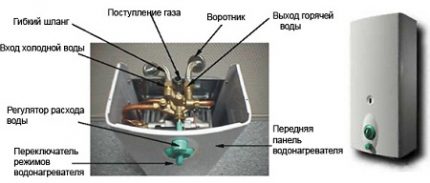

Before starting work on cleaning a household gas water heater, you need to get acquainted with the device device in order to properly disassemble it
Recommended: Can the wallpaper be washed for painting? We analyze materials
The process of heating the water is accompanied by the formation of a hard sludge, which gradually accumulates inside the heat exchanger. The pipes become clogged with deposits, as a result, the quality of heating deteriorates, the operation of the instantaneous water heater becomes insufficiently effective.
Regular column cleaning can help avoid these problems. In addition to scale, other contaminants can collect inside the device, it all depends on the quality of the water.
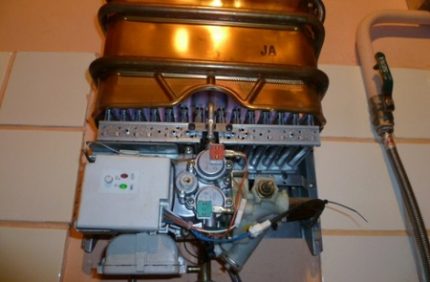

The household gas water heater is not particularly complicated: water moves through the heat exchanger pipe, the burner heats it up, the ignition turns on automatically
The following signs indicate that it is time to clean the column:
- the pressure from the tap with hot water is much weaker than the jet from the cold tap;
- the pressure is good, but almost immediately after turning on the column goes out;
- the device stopped turning on altogether, regardless of the pressure;
- there is insufficient heating of the flow in comparison with the previous state;
- the water heats up to the desired temperature, but too slowly.
Some malfunctions can also be observed in the event of a breakdown of the shut-off valve, which is installed at the inlet to the column. It does not hurt to first check it, and only then proceed to cleaning.
Means for cleaning the gas column
The rules for caring for the gas water heater are described in detail in the instructions for the device and it can be dangerous to deviate from these requirements. If the water heater suddenly becomes clogged, use only the agents recommended by the manufacturer to clean it. They should also be indicated in the relevant paragraphs of the operating manual. And it is better to entrust the cleaning process to professionals. In this case, not only will the blockage be removed, but the warranty will also be preserved.
Important! Unauthorized reading with unauthorized means is hazardous to health! If during the process of descaling or burning one of the elements of the column is damaged and a gas leak appears, you must immediately call 104.
Only if the user understands all the possible consequences and accepts responsibility, you can clean the device yourself. What and how to flush the gas water heater (for example, the Ariston brand) from scale in this case? You can also use ready-made preparations or alternative methods. Which is better and more effective: "vigorous" chemistry or "grandmother's" cleaning, the comparative table will show:
| Solves the problem | Folk remedy | Chemical drug |
| Scale inside the heat exchanger | A mixture of 0.5 liters of hot water and 100 g of citric acid. | Calgon or Anti-scale (erodes the layers of scale inside the pipes). |
| A dense layer of carbon deposits (can only be removed from the heat exchanger, the gas part is cleaned by specialists) | Dilute table vinegar and warm water in a 1: 3 ratio. | You can use 7-10% hydrochloric acid or other strong chemicals. Important! Work requires accuracy: the product should never get on the skin or mucous membranes. |
Second cleaning method
The unit must be cleaned every 6 months, but at least once a year. If there is an agreement on gas supplies, then the company's specialists must timely service the gas boilers. If you want to clean the column on your own, then you must follow the following instructions:
- 1First, you need to turn off the gas, the cock is usually located under the device. Then you need to loosen the bolts that secure the casing, then unscrew them and clean everything with a needle with 4 edges. Today it is possible to buy a special boiler cleaning brush, which is more convenient to use than a needle. The next step is to rinse the burner sections in a degreasing agent. If the wick is clogged, it must also be cleaned with a needle or metal scraper. At the last stage, it is necessary to assemble all the parts of the column in the reverse order and, before starting the gas, fill the unit with water.
- 2 A stiff brush can be used to clean the burners in the gas pipe. The pipe should be wire cleaned and rinsed with water and solvent. The upper area of the burner is cleaned with fine sandpaper.
- 3 Units that are cleaned in a timely manner will work much longer. The fire will be glare-free and even. If it is noticeable that the column is smoking, the fire is uneven, weak or, conversely, strong, then it must be cleaned. An uncleaned machine is dangerous.
Descaling: work procedure
To carry out such a manipulation, you can use both folk remedies and chemical solutions. Having cast your vote in favor of chemistry, you must follow the instructions exactly. If you choose citric acid or vinegar, then the work consists of the following stages:
- the gas water heater is turned off;
- the heat exchanger is disconnected from the rest of the elements by hand and removed from the wall, water is drained from it;
- at the same time connect a hose to the pipe that supplies water to the column to avoid leaks;
- with a pear, syringe or watering can, the resulting solution is poured into the pipes of the heat exchanger;
- now the heat exchanger body is lowered into a deep basin with the same mixture and left in this state for several hours or overnight.
After that, the part must be rinsed well under running water, connected back to the column (as an option, the column of the Ariston FAST R ONM model) and then start the device. Pressurized water will remove all scale, leaving the pipes perfectly clean.
Nuance: It is easy to check the efficiency of your work - just look at the color of the water: if it is transparent, then all the scale has come out.
Anyone who dreams of a new device will be interested in reading: Replacing an old gas water heater with a new one: 5 important points
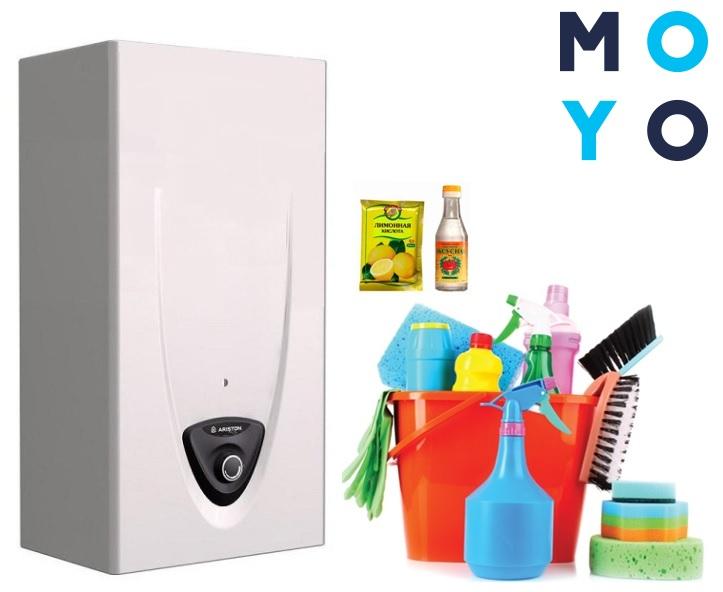

Cleaning the water heater from soot
The products of fuel burnout over time cover the lower surface of the radiator fins, this is facilitated by:
- long-term use of the maximum flame of gas burners;
- insufficient draft in the chimney due to poor exhaust;
- poor ratio of gas and oxygen in the air, contributing to its incomplete combustion;
- excessive content of impurities in the gas mixture;
- condensation droplets containing soot on the radiator fins from the chimney.
Cleaning from soot is carried out with an area of contamination of more than 30%, in most episodes it is combined with the elimination of scale.It is not necessary to call a master to remove the soot layer from the radiator plates, but in order to save financial resources, you will have to independently remove the heat exchanger from the water heater case, which is a task of average complexity for an ordinary man in the street.
When carrying out this operation, you will need the following plumbing and household tools:
- An adjustable plumbing wrench, in rare cases a gas wrench (Bacho pipe wrench), designed to work with squeegee nuts.
- A set of Phillips and flat screwdrivers, chisel.
- Pliers, pliers, or round nose pliers.
- Consumables - paronite gaskets, flax fiber.
There is a wide range of gas water heaters of domestic and foreign production on the market (Vector, Bosch, Astra, Neva, Oasis, Junkers, Termet, Electrolux), with the same principle of operation, they have different assembly schemes, so we will focus on the general stages of their disassembly to remove the heat exchanger:
- Turn off the water and gas supply, remove the upper protective casing and handles, disconnect the water supply pipe from the heat exchanger, pulling out the fixing latches and taking it to the side.
- They do the same with the outlet of the coil, unscrewing the flexible hose from it, remove the coarse filters from both outlets and put them aside.
- The reverse thrust sensor is removed and taken to the side, the gas burner unit is unscrewed from the unit frame and removed to the outside.
- Snap off the fixing plate from the column housing and remove the brackets holding the heat exchanger, unscrew the additional screws securing the coil housing, after which it is taken out and subjected to further cleaning.
Dismantling the heat exchanger of the water heating column
The heat exchanger can be easily cleaned of soot by the following methods:
- Place it in a plastic bowl with warm water and add a household dishwashing detergent to it, wipe the oily soot with a soft sponge.
- Laundry soap, which is grated and placed in hot water, is a good way to remove soot.
- While cleaning from soot and scale, a cleaning solution is poured into the inverted coil and left in this position for several hours - during this time scale should completely dissolve in the decalcifier.
- Since the gas burner unit is removed during disassembly of the coil, it can also be cleaned by dipping it into a bowl of water and household dishwashing detergent and wiping the contaminated areas with a sponge. After cleaning, it is washed several times in warm water and dried thoroughly, otherwise the water trapped in the shallow channels of the igniter and wicks will impede the passage of gas.
Cleaning the heat exchanger from soot
Can the heat exchanger be cleaned without dismantling?
Immediately the answer is: "Yes, you can." To do this, it is necessary to remove the front protective panel and disconnect the heat exchanger from the pipe that supplies water to the gas column. A drain hose is connected in its place.
When these preparatory procedures are completed, any chemical agent (or folk composition, if desired) is taken and poured into the pipes of the heat exchanger through the inlet. It is worth filling the "insides" slowly, in a thin stream, in order to avoid a harsh reaction and pushing the product back.
In this form, the device is left for 2-3 hours. After the expiration of the time, you need to reconnect the hose and drain the waste water with scale and other impurities. Then turn on the column and check its operation.
How to protect against limescale
There are three types of filters that can help prevent limescale build-up.
Water softener filter
It is a small plastic tube with a small tube with salt crystals inside. When liquid passes through such a tube, its composition changes. Thanks to this, the amount of scale on the surfaces is reduced by 2-3 times.
Magnetic filter
In magnetic models, two small magnets are installed, which form a field. The water passing through such filtration structures is purified and softened.
Removal of soot and grime
Cleaning the gas water heater (for example, the Bosch Therm 4000 O WR model) from combustion products, as well as from scale, should be entrusted to professionals, especially when the device is under warranty. You can only remove soot from the surface of parts on your own without disassembling the gas part. How to do it? The process takes 10-15 minutes and consists of the following stages:
- the gas supply is turned off and the upper case is removed;
- all internal elements are gently wiped with a rag or cleaned with a vacuum cleaner;
- the cover is installed back and the functionality of the device is checked.
If the gas wick starts to burn weakly, it means that the nozzle is clogged. It is located on the gas manifold, next to the pressure sensor. You can clean the nozzle with an ordinary thin wire and a stiff brush. Upon completion of work, be sure to check the element for gas leaks. To do this, lubricate the burner with soapy water (bubbles appear in the event of a leak)
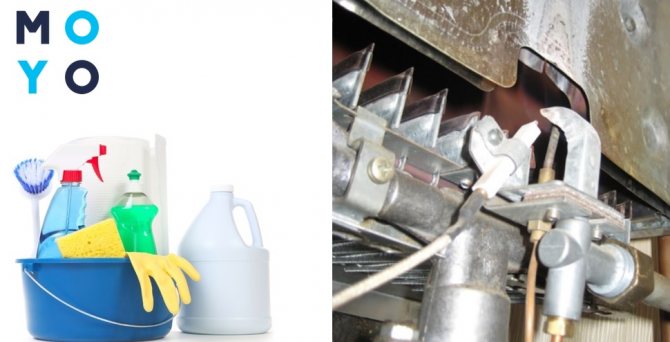

Why does soot appear
Many owners of gas water heaters are faced with the problem of soot. To get rid of such contamination, you can contact a specialist, however, these works are not difficult, so you can do everything yourself. In cases where dirt appears in the holes of the nozzles, it will be possible to do without using a small brush or wire of small thickness.
Traces of soot very often appear in the unit due to leaks that occur in the pipes. At this time, the release of fuel is so weak that households are unlikely to notice its smell. To identify such violations, you need to check the pipe connection sections. To do this, take a brush and apply a soap solution with them. If the applied layer is covered with bubbles, this will indicate that it is time to call the gas service.
The reason for the contamination of the gas column can also be the poor quality of the water. Foreign elements from the liquid can accumulate and, as a result, settle on the filter mesh. This negatively affects the throughput of the unit. Those inclusions that nevertheless managed to overcome the filter barrier can begin to collect on the membrane part. Under such conditions, this part stops responding correctly to pressure changes.
Another common problem with gas columns is scale. It appears due to the crystallization of salts that are present in the composition of the liquid. Here it must be borne in mind that the higher the temperature value of the water, the sooner the salt will accumulate on the important components of the equipment. In most cases, scale appears in such equipment due to the constant operation of the burner or due to heating, which exceeds the 50-degree mark.
Better prevention than cleaning
Prevention is necessary to prevent scale, which is the main scourge of gas water heaters (for example, such as Zanussi columns). It appears not only as a result of salt deposits from hard water, but also as a result of the constant high temperature in the device. To keep the pipes clogged with this "filth" as little as possible, it is necessary to set the optimal temperature regime.
Another way to prevent limescale is to install water filters or electric softeners. They keep harmful salts out, allowing the heat exchanger tubes to last longer. However, the cleanliness of the filter and electric softener must also be monitored.
You may be interested in: TOP-10 gas water heaters of 2017
Method classification
To remove scale from the device, it can be completely disassembled, you can do without these measures. In the first case, the level of pollution is serious.In the second, only the radiator is cleaned.
Another way is to clean the igniter, electrode system and water block.
If the situation obliges you to disassemble the device, it does not hurt to have an idea of \ u200b \ u200bthe scheme of its device.
A typical drawing of such units is as follows:
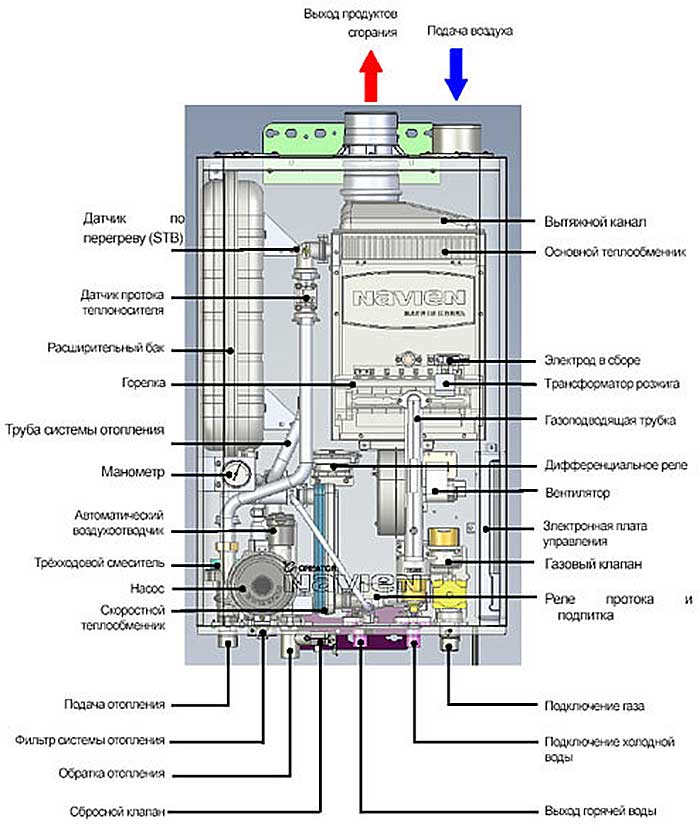

If the gas water heater is clogged thoroughly, the fire of its burner will turn yellow. This is the main symptom of a serious blockage.
If the igniter produces a weak flame, localized elimination of soot is required.
Removing scale in the heat exchanger
To flush the heat exchanger of a conventional gas column, you first need to find the valves that shut off the flow of gas and water to the device, and then turn them.
At the same stage, it is recommended to get the instruction manual and refresh the information about the device device, as well as the manufacturer's recommendations. This will avoid mistakes during dismantling.
To disassemble the column, you need the usual tools that are at the disposal of any experienced craftsman:
- adjustable and pipe wrench;
- straight and Phillips screwdrivers;
- paronite gaskets;
- a hose with a length of at least half a meter;
- a metal clamp to secure this hose.
The hose is connected to the outlet of the heat exchanger and lowered into the sink so that the waste water with contaminants can be drained into the sewer. If this is not possible, you will also have to stock up on a large enough container to drain the water. The protective cover is removed from the column. Be careful not to break the control panel.
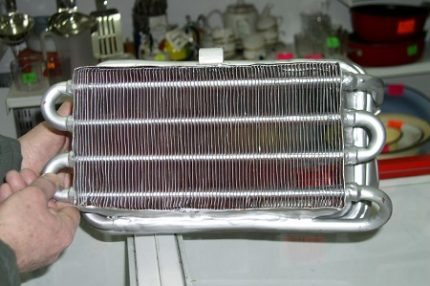

To clean the heat exchanger from scale, it is usually dismantled, and then reinstalled in place, sealing the threaded connections
Now you need to remove the water filter, which is usually fixed with a nut. The filter should be further washed and reinstalled. If the deposits are too tough, it is recommended to use chemical cleaners to remove dirt from the mesh. Damage to the filter can be found during the rinsing process. In this case, it is better to replace it.
Now you need to disconnect the heat exchanger from the water pipes, usually in these places a conventional threaded connection is used, which should simply be unscrewed. The heat exchanger is removed from its hinges and turned over. Some masters advise to put it in a sufficiently spacious container during cleaning so that aggressive chemicals do not leak onto the floor.
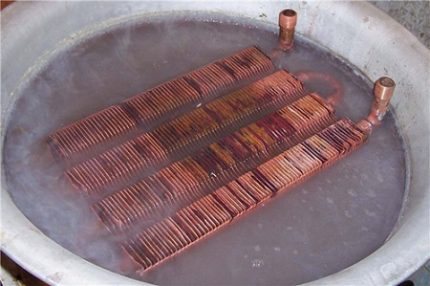

To clean the heat exchanger thoroughly, it can be placed in a spacious container with a cleaning agent. Processing time depends on package instructions
As a cleaning agent, you can use suitable products, for example, "Anti-scale". The usual 9% vinegar solution and other household compounds will also work. You can make a citric acid solution: 100 g per liter of water.
Some have had a positive experience of descaling with drinks like Pepsi-Cola or Sprite, which contain phosphoric acid. But you should not use vinegar essence for these purposes, it can corrode the walls of the pipes, you will have to carry out serious repairs.
The heat exchanger is turned over and the cleaner is poured into it using a rubber bulb or a large syringe. Usually you need at least 500 ml of the substance, but not more than a liter. After that, vinegar or citric acid is left inside for about a quarter of an hour. When using industrial cleaners, it is recommended to follow the instructions.
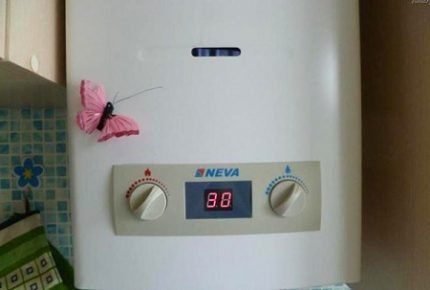

It is necessary to remove the protective casing from the gas water heater carefully so as not to damage the electronic control panel and other elements of the device.
At the end of cleaning, the solution is drained, and the pipes are washed from the accumulated dirt. To do this, the inlet of the heat exchanger is again connected to the water supply, and a container is placed at the outlet to collect dirty water.
Flushing is carried out until a clean stream appears. In the presence of serious contamination, a one-time cleaning procedure may not be enough, it will have to be repeated again using a fresh portion of the cleaner.
Upon completion of the work, it is necessary to assemble the column in the reverse order. The heat exchanger is connected to the water supply. In this case, the threaded connections should be sealed and treated with graphite grease. All gaskets present at the installation site must be replaced immediately with new ones.
Now it is necessary to reinstall the washed coarse filter, put on the casing on the device and supply gas and water to the column again by unscrewing the corresponding valves. It remains to perform a test run of water to make sure that the column is working properly.
Electromechanical descaling methods
To clean the coil of the heat exchanger from scale, you can use the mechanical method of supplying the cleaning solution under pressure, in suburban conditions for this purpose it is effective to use a mini-high-pressure washer, while the water heater is disassembled.
You can also speed up the cleaning process using a small-sized centrifugal electric pump or a vibration pump (many use a unit from an old washing machine). To do this, the electric pumping equipment is connected to the inlet of the coil and the container with the cleaning solution, and the liquid from the outlet is drained into the main tank with antiscale, thereby ensuring the circulation of the composition in a circle. The use of an electric pump significantly speeds up the process and improves the quality of cleaning - the liquid is passed through a coil with increased pressure, which contributes to the effective detachment of scale.
How to descale without removing the heat exchanger
To remove scale without removing the radiator, simply remove the front panel of the column and disconnect the water heater tubes from the water unit. Do not rinse the radiator together with the "frog", otherwise the detergent will negatively affect the membrane and other elements of the water block.
There are 3 options for flushing the heat exchanger without removing it:
- Connect the hoses to the circuit connections and pour the cleaning agent through the funnel. Put a bucket in the place where the liquid comes out.
- Remove the water heater from the wall, turn it upside down and place it on the floor. Periodically, it is necessary to fill in a citric acid solution and flush out the scale with water through a hose.
- Make a booster - a device for pumping liquid through the circuit. Its scheme is simple to implement: a pump, connecting pipes and a tank with a detergent solution.
To protect the booster pump mechanism from clogging, a strainer that retains scale is installed on the suction port.
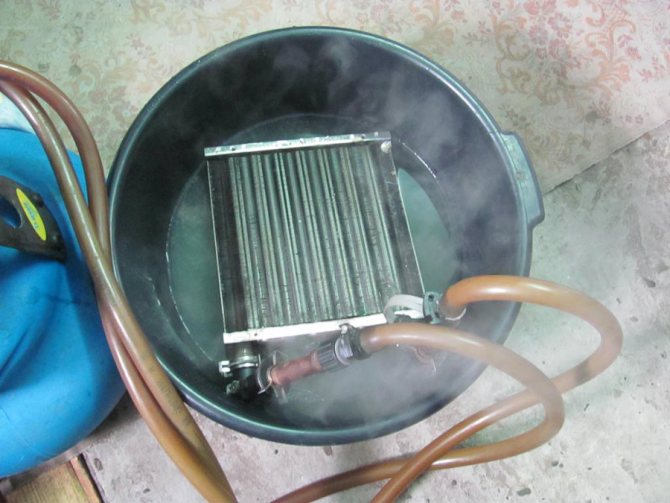

Clean the burner and combustion chamber with a long-bristled brush. Use a vacuum cleaner to remove dust.

